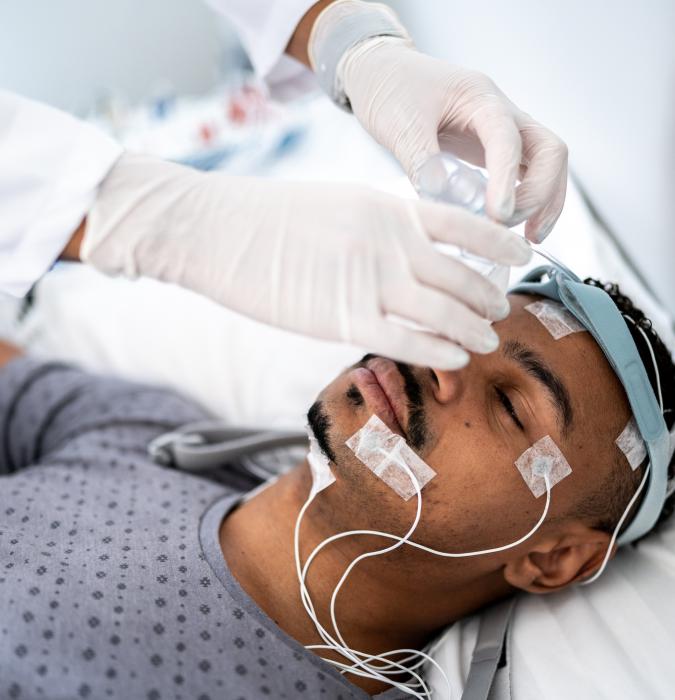Our approach to care
Types of common sleep appointments
Centra offers overnight diagnostic testing and studies in the sleep lab. A patient stays overnight in a room – designed like a hotel – with monitors connected to their body to track sleep patterns. A certified polysomnographer runs the study, and a board-certified sleep physician reads the results to suggest treatment.
The diagnostic study is the first-night study when the sleep process is measured and will provide the sleep specialist information required to recommend treatment and determine the need for additional testing.
Polysomnogram (PSG): Full night sleep study that is performed in the sleep center. Used to diagnose a range of sleep disorders. A variety of wires are attached to patients, which transmit signals to the control room, where technologists are monitoring for the duration of the night.
Home Sleep Apnea Test (HSAT): Test that is used to screen for and diagnose sleep apnea. The day of their appointment, patients will receive instructions from a technologist on the application of the testing equipment, as well as instructions to utilize at home. Patients take the testing equipment home to sleep with and return the equipment the following day.
Polysomnogram with therapy (PAP): Like the diagnostic polysomnogram, but these are for patients who are already diagnosed with sleep apnea and need positive pressure therapy. These studies allow the technologist to manipulate the positive pressure to meet each patient’s individual needs to treat their sleep apnea.
Multiple Sleep Latency Test (MSLT): Diagnostic test performed in the sleep center to evaluate patients for hypersomnia or Narcolepsy. These tests are performed following a diagnostic polysomnogram with normal results.
CPAP Titration Polysomnography: This test is performed when the first study is positive for Obstructive Sleep Apnea and involves fitting for a mask that is adjusted to fit comfortably over the nose. The mask is attached to a positive airway pressure device that treats breathing problems during sleep. This testing measures the sleep process while using Continuous Positive Airway Pressure Therapy. The record will provide the sleep specialist information needed to recommend the appropriate pressure to treat the sleep apnea.
Mask Fit Session: These are appointments for patients who are having trouble with the interface (mask) they are using for their pressure therapy to treat their sleep apnea. We work with patients to understand their struggle and properly fit them with a more comfortable option.
PAP Nap: These are appointments for patients who are struggling to be compliant with their PAP therapy due to pressure intolerance. These are shorter appointments than a full sleep study, usually lasting about 4 hours. Patients work with a technologist to ensure their mask interface fits appropriately, and then work through techniques to get comfortable with the pressure from the machine.
What to expect for your sleep study section
Before any test
- Try to avoid caffeine and naps prior to your appointment
- Get a good meal prior to your appointment
- Make sure that your scalp and skin are clean and free of oils or product
- Please remove gel nails or fingernail polish from one of your index fingers
After any test
A board-certified sleep physician will interpret the data from the procedure. A copy of the interpretation report will be sent to the referring provider. Some patients will follow up with their referring provider while others may follow up with a board-certified sleep physician. You will be given those details at your appointment.
Overnight, in-center study:
You will arrive at the sleep center by 8pm for registration. Please bring:
- Insurance Card and Identification
- Something comfortable to sleep in (i.e., Pajamas)
- Any medications you would take during the duration of your visit
- You may bring a book, tablet, phone, or laptop for winding down. We provide Wi-Fi and TV in the rooms.
- You may bring a preferred pillow if you like.
- You will have your own bathroom and may shower prior to leaving, just bring your own toiletries.
A technologist will get you from registration and bring you to the sleep center where you will be shown to your private room. Your technologist will explain the procedure to you and answer any questions you have while applying the sensors. This process takes about 30-45 minutes. Once complete, you will get in bed and your study will begin. You will be able to get out of the bed to use the restroom during the night as needed, but your technologist will have to unplug a couple of cables to make you mobile.
In the morning, your technologist will wake you up, remove all the sensors and ask you to fill out some morning paperwork. Technologists monitor patients via video and audio recording during the entire process until all sensors are removed. You will have the option to shower before you leave, but patients must be ready to leave within 1 hour of your wake time.
Home Sleep Apnea Testing
You will be given an appointment date and time to pick up your home testing device. This appointment generally lasts 30 minutes or less and is done in a group setting. A technologist will greet you and guide to the room where the instruction will take place. You will be given some paperwork to complete and a kit with all of the necessary equipment for your test.
Along with the equipment, you will be given written instruction and a website address to watch a video, if you prefer. The technologist will go over the equipment with the group and answer any questions. You will take the device home to use that night and return the device the following morning by 9am. (Please note, it is extremely important to return the device the following day so it can be downloaded and processed.)

